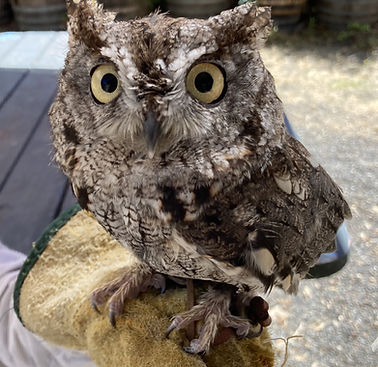The more we know the more amazed we are! Here are some interesting facts, mainly about owls. Check back for new fun facts.
Saw-whet Owls
One of the cutest members of the owl family - and the model for Sammi - is the Northern Saw-Whet Owl. How did this bird get its unusual name? One story is that in the early 1800’s this little owl’s range included the U.S./Canadian border. This 7 ½” curious owl was a visitor to farms and camps. The French were fond of this bird and called it chouette (shoo-ET), which is French for “little owl.” English speakers may have morphed this word into “saw-whet.”
Its bright yellow eyes bordered by white eyebrows add to the sweet look of this owl. The Saw-Whet also has white spots on its head and back. A nocturnal hunter, it feeds primarily on small rodents and little birds.

The Laysan Albatross

Sammi thought you might like more information on the birds in the books. But where do we start? All the characters are flapping their wings wildly to get Sammi’s attention. But
Sammi has decided to feature Albert the Albatross from Aloha from Sammi, Albert and his Albatross Air Service safely transport Sammi from California to Kauai’i for Patti Pueo’s birthday party. Without Albert, Sammi would not have had the Hawai’I adventure. So here are some interesting facts about the Laysan Albatross:
A Laysan Albatross lives most of his life on the open ocean, coming to land only for breeding season. The Hawaiian Islands are their primary nesting spot When the Albatross couple gets together they make a nest of grass and
bushes where the female lays one precious egg. If you are in Hawaii in winter you might be able to see the parents with their chick.
This amazing world traveler has a wingspan of over 6 feet! The Albatross holds its wings out like a glider, taking advantage of the strong gusts of sea wind. These birds can soar many miles without needing to flap their wings.
Did you know that many birds don’t can't smell a thing? The Albatross, however, has an excellent sense of smell. It has tubular-shaped external nostrils and a sharp hooked beak. These characteristics help this bird find and catch jellyfish, fish and small crustaceans and “eat on the fly” as it travels.
Sammi is giggling about this last fact. The Albatross is a graceful and skilled flyer yet stumbling and clumsy on land. Watching these birds land, the Hawaiians gave this Albatross the name “gooney bird”.


Western Screech Owls
You hear a screech in the night. You think: “That must be a Screech Owl".
But it’s a case of mistaken identity. That call probably belongs to aBarn Owl. A Western Screech Owl’s call is a series of melodic hoots that accelerate like a bouncing ball.
This small but capable little hunter is the model for “Owliver” in the Sammi series.The Western Screech Owl is about 8.5 -9 inches in length. It has a compact body, a large head and short tufts. Its gray, mottled feathers provide perfect camouflage in the woodlands where it resides. In fact, standing next to an oak trunk, this little owl almost disappears!
Like all owls, the Screech Owl is an excellent raptor, feeding
mostly on insects, but also small mammals, birds and reptiles.
So when you are listening at night and hear a call that sounds like a bouncing ball, say hello to the Western Screech Owl.
Pippin, a Western Screech Owl, is an ambassador at The Bird Rescue Center in Santa Rosa.
How far can an owl turn its head?
Owls have HUGE eyes. They're so big they can't move. So, if an owl wants to see, he has to move his head rather than his eyes. A lot of people think an owl can turn its head ALL the way around. An owl can turn his head 270 degrees - that's 3/4 of the way around. So he can turn his head to the right and end up looking to the left.
Try turning your head (no cheating, don't move your shoulders!) as far as it will go. If you're like most of us people, you can only turn it about 45 degrees or 1/4 of the way.
How do they do this? One factor is that they have twice as many vertebrae in their necks than we do. We have 7, owls have 14.
And, as you think about this fact, don't forget that giraffes also only have 7 vertebrae in their necks!


